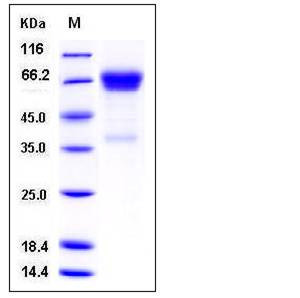Human OLFM4 / GW112 Protein (His Tag)
bA209J19.1,GC1,GW112,hGC-1,hOLfD,OlfD,OLM4,UNQ362
- 100ug (NPP4127) Please inquiry
| Catalog Number | P11639-H08H |
|---|---|
| Organism Species | Human |
| Host | Human Cells |
| Synonyms | bA209J19.1,GC1,GW112,hGC-1,hOLfD,OlfD,OLM4,UNQ362 |
| Molecular Weight | The recombinant human OLFM4 consists of 501 amino acids and predictes a molecular mass of 56.6 kDa. In SDS-PAGE under reducing conditions, the apparent molecular mass of rh OLFM4 is approximately 65-70 kDa due to different glycosylation. |
| predicted N | Asp 21 |
| SDS-PAGE |  |
| Purity | > 92 % as determined by SDS-PAGE |
| Protein Construction | A DNA sequence encoding the human OLFM4 (NP_006409.3) (Met 1-Gln 510) was fused with a polyhistidine tag at the C-terminus. |
| Bio-activity | |
| Research Area | Neuroscience |Cell Type Marker in Neurodevelopment |Glial Cell Markers |Oligodendrocyte marker |
| Formulation | Lyophilized from sterile PBS, pH 7.4 1. Normally 5 % - 8 % trehalose, mannitol and 0.01% Tween80 are added as protectants before lyophilization. Specific concentrations are included in the hardcopy of COA. |
| Background | Olfactomedin-4, also known as G-CSF-stimulated clone 1 protein, Antiapoptotic protein GW112, and OLFM4, is a secreted protein which contains one olfactomedin-like domain. The OLFM4 gene was recently reported to inhibit various apoptotic pathways and promote proliferation of cancer cells, suggesting that OLFM4 might serve as a diagnostic marker for human cancers. Thus, OLFM4 mRNA might be a useful tool to support the diagnosis of cancer, irrespective of the clinical stages. It is overexpressed in a number of human tumor types, especially in those of the digestive system. GW112 is associated with GRIM-19, a protein known to be involved in regulating cellular apoptosis. Functionally, GW112 could significantly attenuate the ability of GRIM19 to mediate retinoic acid-IFN-beta-mediated cellular apoptosis and apoptosis-related gene expression. In addition, GW112 demonstrated strong antiapoptotic effects in tumor cells treated with other stress exposures such as hydrogen peroxide. Finally, forced overexpression of GW112 in murine prostate tumor cells led to more rapid tumor formation in a syngeneic host. OLFM4 is an important regulator of cell death that plays important roles in tumor cell survival and tumor growth. As a candidate gene for cancer-specific expression. The serum olfactomedin 4 (OLFM4) is a useful marker for Gastric cancer (GC) and its measurement alone or in combination with Reg IV has utility in the early detection of GC. GW112 has an antiapoptotic property against the cytotoxic agents-induced apoptosis. It suggested that GW112 could be an important mediator in NF kappaB-dependent tumorigenesis of digestive tract tissues. |
| Reference |
